Gondwana—Species assessment
Species surveys were conducted to detect priority threatened species in burnt habitats. Unburnt habitats were also surveyed as a comparison, to see if they were acting a refuge for recovery. Surveys were also used to establish broader spatial distributions, relative population size and breeding status where possible.
The following priority species were surveyed.
- Brush-tailed rock-wallaby (Petrogale penicillata)
- Hastings River mouse (Pseudomys oralis) and New Holland mouse (Pseudomys novaehollandiae)
- Long-nosed potoroo (Potorous tridactylus tridactylus)
- Spotted-tailed quoll (Dasyurus maculatus maculatus)
- Albert’s lyrebird (Menura alberti)
- Glossy black-cockatoo (Calyptorhynchus lathami)
- Fleay’s barred frog (Mixopheys fleayi) and Cascade treefrog (Litoria pearsoniana)
Brush-tailed rock-wallaby (Petrogale penicillata)
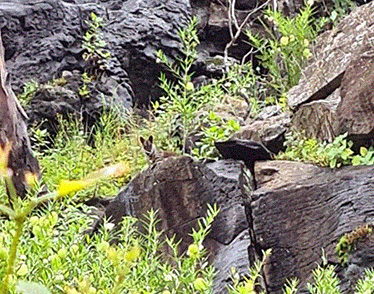
The brush-tailed rock-wallaby is listed as Vulnerable under both the Queensland Nature Conservation Act 1992 the Commonwealth Environment Protection and Biodiversity Conservation Act 1999. Populations have declined due to habitat loss and disturbance, and increased predation, especially from feral cats and foxes. The preferred habitat is a complex of rocky outcrops that provide refuge from predators, with areas of open forest with a grassy understorey for foraging.
The post-fire surveys were undertaken across 17 known brush-tailed rock-wallaby sites associated with Mt Barney and Main Range National Parks to document their presence or absence across suitable burnt and unburnt habitats (the latter can be important refuges to be protected from further fires). Ecologists counted direct sightings of brush-tailed rock-wallabies and assessed scats to determine their recent presence in an area.
Brush-tailed rock-wallabies were recorded at 14 of the 17 sites surveyed. Recent evidence of the presence of dogs at two of the remaining three survey sites may account for the wallabies’ absence at those locations. Good recovery of grass and herbs was observed at the burnt survey sites one year after the fires, which provides a critical food resource as well as vegetative cover from potential predators whilst foraging.
Recommendations to support the ongoing recovery of brush-tailed rock-wallaby populations in Main Range and Mt Barney National Parks include protecting known colonies from future bushfires, feral cats, foxes and wild dogs and targeted control of invasive weeds to protect their habitats. Planned burns can also be strategically undertaken to maintain their optimal foraging habitats of grassy woodlands. Subsequent monitoring of populations will aim to survey additional fire-impacted sites.
Hastings River mouse (Pseudomys oralis) and New Holland mouse (Pseudomys novaehollandiae)
The Hastings River mouse is listed as Vulnerable under both the Queensland Nature Conservation Act 1992 the Commonwealth Environment Protection and Biodiversity Conservation Act 1999. It was first recorded from Main Range National Park in 2010, with a subsequent survey program also documenting the presence of the vulnerable New Holland mouse. Both species are at risk from habitat loss, inappropriate fire regimes that alter their required habitat and predation from introduced carnivores. Their diet includes herb foliage and stems, seeds, flowers, fungi and invertebrates.
Post-fire surveys were undertaken across two known localities in grassy open eucalypt forest and woodland by setting 415 baited traps each night for four nights. A total of five Hastings River mice and five New Holland mice were captured across both burnt and unburnt sites. At the time there was a plague of introduced House mice, with more than 1,000 caught over the four nights, which would have reduced captures of native species because traps were already occupied.
The survey confirmed that the two species of native mice survived the 2019 fires and preceding drought. Whilst the fire had impacted most of the understorey and mid-storey vegetation on burnt sites, the vegetation was noted as regenerating and there was evidence of recent breeding in the captured Hastings River mice.
Recommendations to support the recovery of these two species of threatened native rodents include control of invasive weeds to protect the natural regeneration of habitat and strategic use of planned burns maintain optimal habitat structure at other sites. The timing of future monitoring efforts will seek to avoid peak populations of introduced mice.
Long-nosed potoroo (Potorous tridactylus tridactylus)
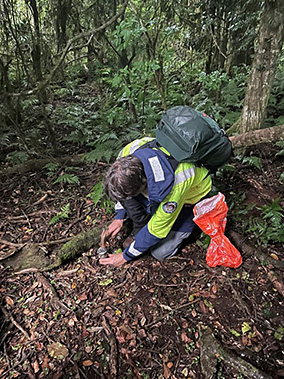
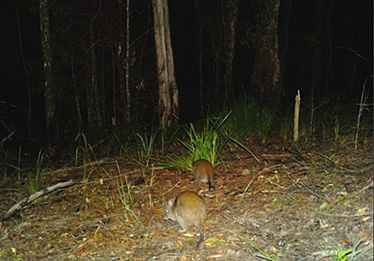
The long-nosed potoroo is listed as Vulnerable under both the Queensland Nature Conservation Act 1992 the Commonwealth Environment Protection and Biodiversity Conservation Act 1999. They occur in subtropical and warm-temperate rainforest, wet sclerophyll forest, tall open forest and coastal heath where they can access low dense vegetation for shelter and fungi for food.
Long-nosed potoroos are thought to promote the establishment of mycorrhizal fungi after a disturbance, such as fire, by distributing fungal spores from nearby undisturbed habitats. Conservation threats include the loss, fragmentation and degradation of habitat, unsuitable fire regimes and feral predation.
To survey the cryptic long-nosed potoroo post-fire, 47 camera traps were deployed across 58 sites for more than 8 months across the Gondwana World Heritage area. The use of specialised baits at a subset of cameras aimed to attract potoroos to the field of camera vision.
At Mt Barney National Park, long-nosed potoroos were detected at one site, with up to two potoroos captured on camera on three different occasions (which could possibly be the same individuals). At Main Range National Park, an individual potoroo was detected by three different camera traps set at burnt sites.
The results confirmed that the long-nosed potoroo has persisted at some sites following the 2019 fires in both burnt rainforest and open forest habitats. The potential ecological impact of the fires across these sites was in the lower two categories, implying a lower impact to sub-canopy or canopy and a better capacity for native regeneration.
Recommendations to support ongoing recovery of long-nosed potoroos include control of feral predators. At two of the four sites at which potoroos occurred, feral cats and foxes were captured by the same camera. To protect their habitat, the risk of future fires to the fire-sensitive areas need to be managed. For more fire-tolerant areas, the use of planned burns to maintain low vegetation structure may be appropriate. The targeted control of invasive weeds that can dominate the understorey is also important to ensure habitat connectivity and enable safe movements of potoroos during and after fires.
Spotted-tailed quoll (Dasyurus maculatus maculatus)
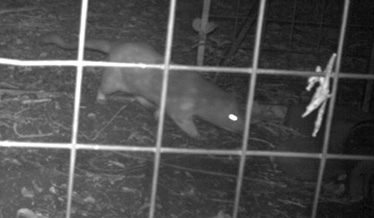
The southern subspecies of the spotted-tailed quoll is listed as Endangered under both the Queensland Nature Conservation Act 1992 the Commonwealth Environment Protection and Biodiversity Conservation Act 1999. This species can occur across rainforest, wet and dry sclerophyll forest, eucalypt woodlands, coastal heathland and riparian forest. A carnivorous marsupial, they actively hunt at night for small mammals, birds, reptiles and invertebrates. Keys threats to their survival include the loss, fragmentation and degradation of habitat, competition and predation from feral predators, lethal consumption of cane toads and loss of den sites due to fire.
To assess the persistence of spotted-tailed quolls, 47 camera traps were placed over 58 sites for more than 8 months across the Gondwana World Heritage area. The use of specialised baits at a subset of cameras aimed to attract quolls to the field of camera vision.
Adult spotted-tailed quolls are typically solitary and occupy large home ranges which makes them difficult to detect for surveys. During the survey period, there were no quolls detected on the camera traps, however, two images were captured on cameras deployed by park rangers in another area of Main Range National Park whilst monitoring for feral pigs. These records were from unburnt rainforest, which may be acting as an important refuge from the extensively burnt landscapes across this park.
Recommendations to support spotted-tailed quolls recover after the fires include the ongoing monitoring and control of feral predators such as cats and foxes, excluding fire from unburnt refugia and ensuring habitat quality and connectivity with targeted control of invasive weeds. Further monitoring is important to identify occupied sites and to focus park management efforts to help protect quoll populations.
Albert’s lyrebird (Menura alberti)
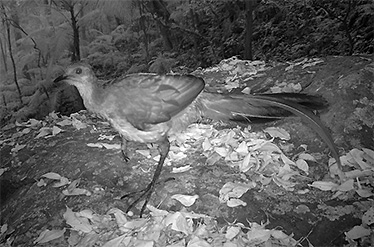
Albert’s lyrebird is listed as Near Threatened under the Queensland Nature Conservation Act 1992. It occurs in rainforest, including cool temperate rainforest and subtropical vine forest, as well as adjacent mixed eucalypt forest with rainforest. Identified threats to the Albert’s lyrebird include the loss, fragmentation and degradation of habitat, predation from feral cats and foxes and impacts from fire.
The survey of Albert’s lyrebirds involved 47 camera traps across 58 sites in the Gondwana World Heritage Area for more than 8 months. In addition, incidental records were made from direct observations or hearing calls whilst undertaking post-fire surveys for other species.
Images of Albert’s lyrebirds were captured at 30 (76%) of the camera sites, as well as at an additional 27 sites from incidental records during the post-fire surveys. This species was widespread across the fire-impacted areas and detected in burnt rainforest and open forest, including sites with a high potential ecological impact level. These results provide an encouraging sign of post-fire recovery for this species.
The risk of predation from feral predators, which typically increases after fire is a key concern for populations of the Albert’s lyrebird. Cats and red foxes were captured on the same cameras that detected lyrebirds at 22 of the 30 survey sites. Whilst the time difference between detections of lyrebirds and feral predators varied, cats were photographed within two hours of a lyrebird image being recorded at three sites in Main Range National Park.
Recommendations to support species recovery include control of feral predators, excluding fire from rainforest and wet sclerophyll ecotones, control of invasive weeds that can modify habitats and protecting habitat connectivity to enable safe movement of the species during and after fires.
Glossy black-cockatoo (Calyptorhynchus lathami)
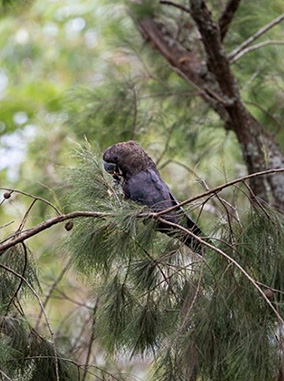
The glossy black-cockatoo is listed as Vulnerable under the Queensland Nature Conservation Act 1992 and Endangered under the Commonwealth Environment Protection and Biodiversity Conservation Act 1999. Glossy black-cockatoos feed exclusively on the seed cones of she-oaks (Allocasuarina species) and nest in eucalypt tree hollows, making them very susceptible to the impacts of the 2019 fires, as well as the preceding drought. Habitat degradation and the loss of mature she-oaks and eucalypts trees through land clearing or disease are additional threats to glossy black-cockatoo populations.
Post-fire surveys were systematically undertaken across 31 sites within the Gondwana World Heritage Area. Detections were recorded by experts from visual observations, hearing calls and finding evidence of recent feeding on she-oaks cones.
The survey results confirmed the presence of glossy black-cockatoos in Lamington, Main Range and Mt Barney National Parks. However, they occurred only in areas that were unburnt or that experienced low to moderate potential ecological impacts from the 2019 fires. At sites that had experienced high to extreme potential ecological impacts, many she-oak trees were dead and the availability of live trees to provide food resources was very limited. Generally, the quality of remaining seed cones was noted as poor across all parks.
Recommendations to support species recovery include the need to protect unburnt refugia from fires across the broader landscape, support for natural regeneration through control of weeds that can compete with she-oaks for available water and nutrients. Ongoing ecological monitoring is essential to assess recovery in habitats and food quality across an expanded the number of survey sites.
Fleay’s barred frog (Mixopheys fleayi) and Cascade treefrog (Litoria pearsoniana)
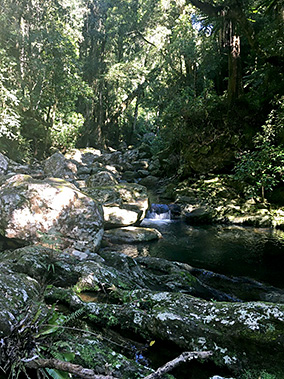
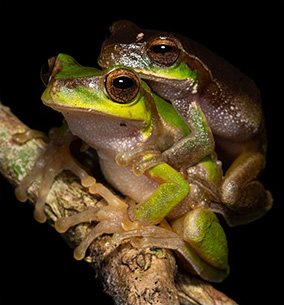
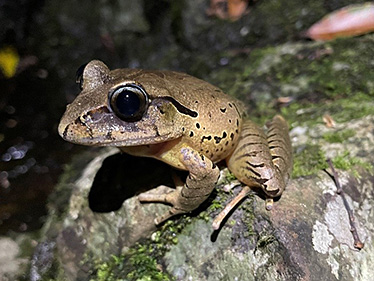
Fleay’s barred frog is listed as Endangered under both the Queensland Nature Conservation Act 1992 the Commonwealth Environment Protection and Biodiversity Conservation Act 1999, whilst the cascade treefrog is listed as Vulnerable under the Nature Conservation Act 1992. Both species are stream-breeding frogs and their populations have declined as a result of habitat degradation (such as by feral pigs or cattle), increased predation (such as by feral cats), drought, disease and invasive weeds altering their habitats. The increased threats from bushfires present additional risks such as direct mortality, loss of habitat and food resources, greater incursion of weeds and pest animals and post-fire runoff that can carry excessive nutrients and degrade water quality.
Fleay’s barred frog and the cascade treefrog occur in the wet forests of the Gondwana World Heritage Area and the 2019–20 bushfires significantly impacted their preferred habitats across Mt Barney National Park (57%) and Main Range National Park (near 40%) and less so at Lamington National Park (between 4 and 8%).
After the bushfires, 12 sites across the three national parks were visually surveyed for Fleay’s barred frog and the cascade treefrog over a five-month period. The results showed that both species persisted within the burnt landscape and bred following the bushfires. The cascade treefrog was found at all 12 sites surveyed and the Fleay’s barred frog was found at 10 sites. The Fleay’s barred frog was not found at the burnt site surveyed in Lamington National Park, although most of the known habitats in this park were not impacted by the bushfires. Across the three fire-impacted parks, both species occurred at sites with various levels of fire impacts, including one site impacted at a high to catastrophic level.
Recommendations to support the ongoing recovery of Fleay’s barred frog and the cascade treefrog include protecting unburnt suitable habitat areas from future bushfires; monitoring, controllling or excluding pest animals that can degrade habitat and water quality or predate upon frogs, their eggs or tadpoles; and controlling invasive weeds that alter or displace native streamside vegetation. Monitoring surveys for both frog species should continue to track recovery and reproductive success. Surveys to improve the current understanding of the distribution and ecology of both the Fleay’s barred frog and the cascade treefrog is also recommended to guide conservation priorities.


